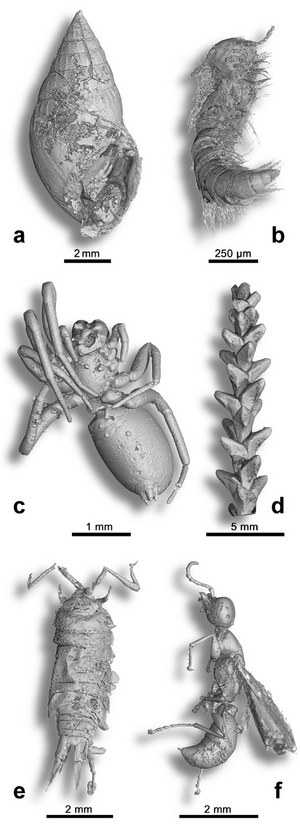April 1, 2008
Embedded in Amber - a new look
Clever combination of high-tech synchrotron X-ray radiation and chunks of opaque Amber. We all know about insects trapped in Amber (fossilized plant sap) however there are a lot more pieces of opaque Amber than there are clear Amber. Some scientists in France are doing some amazing work -- from the European Synchrotron Radiation Facility:ESRF X-rays reveal clues about life 100 million years ago trapped in opaque amberHere is an example of the image quality and the size of the stuff we are dealing with:
Opaque amber accounts for up to 80% of the amber found in Cretaceous sites like those in Charentes. From the outside, it is impossible to tell whether something may be contained inside. Malvina Lak and her colleagues from the University of Rennes and Paul Tafforeau of the ESRF, together with the National Museum of Natural History of Paris, have applied a synchrotron X-ray imaging technique known as propagation phase contrast microradiography to the investigation of opaque amber. This technique permits light to reach the interior of this dark amber, which resembles a stone to the human eye. �Researchers have tried to study this kind of amber for many years with little or no success. This is the first time that we can actually discover and study the fossils contained within�, says Paul Tafforeau.
The scientists imaged 640 pieces of amber from the Charentes region in south-western France. They discovered 356 fossil animals, ranging from wasps and flies, to ants and even spiders and acarians. The team was able to identify the family for 53% of the inclusions.

Click to embiggen
For more information about this facility, here is their Virtual Tour To give you an idea of the size of this machine, the ring is over 800 feet in diameter. Big Science is cool -- very very very cool! Posted by DaveH at April 1, 2008 8:46 PMExamples of virtual 3D extraction of organisms embedded in opaque amber: a) Gastropod Ellobiidae; b) Myriapod Polyxenidae; c) Arachnid; d) Conifer branch (Glenrosa); e) Isopod crustacean Ligia; f) Insect hymenopteran Falciformicidae. Credits: M. Lak, P. Tafforeau, D. N�raudeau (ESRF Grenoble and UMR CNRS 6118 Rennes).
Comments
Post a comment